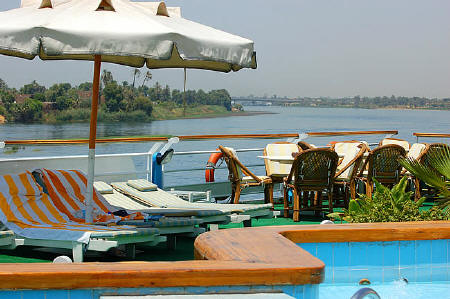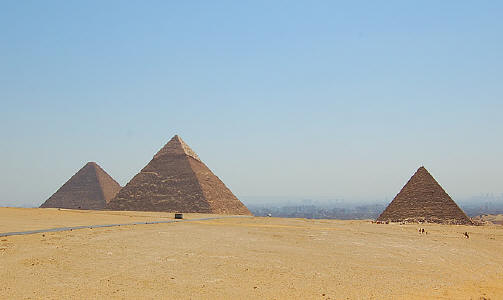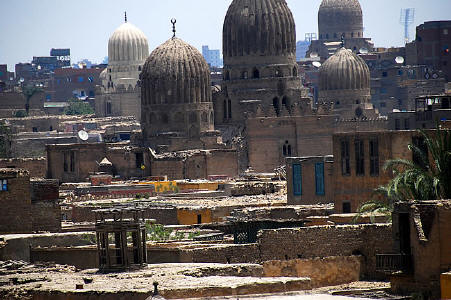

|
Cruising on the Nile
River |
Visiting
Cairo and Giza
Review and
Photos by Karen, Christopher and Alan
Fox used
with Permission
from the Sun Goddess
Ramses II
Royal Mummy Room
Valley of the Kings
Khan El Khalili
City of the Dead


It
feels like the distant past is perhaps not so very far away
I see dead people.
About a dozen of them. Wrapped in crumbling, faded rags and laid out face up,
under glass. Their shriveled bodies are labeled, but I don't recognize most of
their names. There is
one gentleman in the room, however, that even in death seems to rise above the
rest. He is
Ramses II,
widely regarded as the greatest pharaoh of them all.
I'm coming to you this week from the Royal Mummy Room in the Egyptian Museum, a room that makes me feel, more than any other I have ever entered, that the distant past is perhaps not so very far away.
It is barely conceivable that I am
staring at the earthly remains of Ramses II, the ruler whose likeness adorns
more Egyptian monuments and temple walls than any other. He built the twin
temples at Abu Simbel and the mortuary temple Ramesseum, and expanded the
temples in Luxor and Karnak. He battled the Hittites and conquered the Shardana
(pirates of the Mediterranean), and is responsible for the world's first
international peace treaty, a copy of which is on display at the United
Nations. Some (but not most) believe that Ramses II was pharaoh during the
exodus of the Hebrews from Egypt. In the movie
The Ten Commandments,
it was Ramses II who was portrayed so unfavorably by Yul Brynner. He was
husband to at least eight wives (most famous, Nefertari) and fathered 100
children. He reigned for 67 years, longer than any other pharaoh, and lived into
his 90s.
And all of this happened more than
1200 years before
the birth of Christianity.
Ramses II still looks like the kind of person that gets
things done today
One other thing--I'm not making
this up--Ramses II still
looks like the kind of person that gets things done today. Decisive, engaged,
multitasking. And yes, I have been out in the hot sun a lot lately, in case you
were wondering.
The Egyptian Museum is stacked to the rafters with statues
and artifacts from temples, tombs and crypts, and mummies of people, birds and
animals, including enormous Nile crocodiles. I'm glad we took our Nile cruise
before visiting, as so much of what is here came from places we have seen.
There are 120,000 objects on
exhibit and an untold number more still boxed and stored in hallways, nooks and
crannies. An all-new
Grand Egyptian Museum
is currently under construction, and some artifacts, including the most-prized
Tutankhamun Exhibit, will move there upon completion.P
The
Great Pyramids
Since arriving in Cairo, we have visited the Great Pyramids
and Sphinx of Giza, which seem impossibly huge even by today's construction
standards.
The largest of the pyramids, the Great Pyramid of Cheops, was
finished around 2690 B.C. and is one of the Seven Wonders of the Ancient World.
It stretches 448 feet into the sky, with a base that covers an area of 13
acres. As with each pyramid, this one was built to house and preserve the
mummified body of a single pharaoh, for eternity.
Unfortunately, tomb robbers didn't
have much trouble finding these pyramids and others built around the country,
and many were looted within years of completion, eventually leading the pharaohs
to build underground tombs in what came to be called the
Valley of the Kings.
We've also visited the
Khan
El Khalili, one of
the oldest bazaars in the world. The narrow alleys house hundreds of shops
selling almost anything imaginable, and one of the many restaurants, El Fishawy,
has reportedly been open continuously, day and night, for more than 200 years.

We dropped by the
City of the Dead a walled four-mile-long
cemetery filled with tombs, crypts and coffins, and more than one million
living
residents! The burgeoning poor population and nationwide housing crisis have
resulted in an influx of people who sleep in tombs, dry laundry on strings hung
between headstones and use grave markers as desks.
In Old Cairo, we toured an ancient Christian church, a mosque
and a synagogue that are all within easy walking distance of each other. Before
the advent of Islam in the 7th century, Christianity was the most widely
practiced religion in Egypt. Today the country is about 80-90% Islamic and 5-10%
Christian, with a tiny Jewish community and numerous other religions
represented.
From what we have seen, the various religions coexist
peacefully under Egypt's moderate government.
Tomorrow we'll return to the New World, which will
undoubtedly seem even newer than when we left.
We will bid a fond farewell to Hany, our friend and
Egyptologist extraordinaire, who has guided and enlightened our group as we
toured this land that he loves so dearly. More than a little of his appreciation
for antiquity and the Golden Age of the Pharaohs has rubbed off on us.
I will
remember the sands of the Sahara
I will remember the sands of the Sahara, the hot sun on my
face, and the life-giving Nile. And I'll remember my visit to the Royal Mummy
Room and this mute fellow before me who was called Ramses II.
When much of the world was in darkness and chaos, he ruled in
prosperity and erected magnificent structures that are still celebrated 31
centuries later. Time and Hollywood have not been kind to him since, but for
that brief moment when his eyes were open, he saw his empire shine brighter than
all the rest.

Return to Part I: Cairo and Luxor
Return to Part 2: South on the Nile River
Return to the Travel Reviews Directory
For a slideshow of
photos from this leg of the tour, click
here.
To see the itinerary
and prices for
Royal Egyptian
departures, click
here.
For a list of all Egypt
tours and Nile cruises, click
here.
For a map of Egypt and
the Nile, click
here.